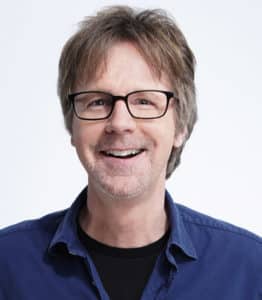One of SNL’s most talented alumni, comedian Dana Carvey reigned supreme during his six-season run creating some of the show’s most memorable characters, including “Church Lady”, “Garth” of Wayne & Garth fame, Grumpy Old Man and bodybuilding “Hans” of Hans & Franz notoriety.
The slightly-built, slightly dorky-looking funny guy was born in 1955 in Missoula, Montana, to Billie Dahl (McDonald) and Bud Carvey. He is of Norwegian, and smaller amounts of English, German, Swedish, and Irish, ancestry. Carvey was raised in San Carlos, California in typical middle class surroundings. His father taught high school business law and his mother, who was also a schoolteacher, had creative outlets as a painter and musician that inspired the young Dana. His gift for inducing laughter arrived at any early age. As young as 9 or 10, Dana was already mimicking characters he saw on TV, with one of his early icons being Jonathan Winters. His musical gifts came in the form of drums and guitar.
While majoring in Communication Arts at San Francisco State, Dana sought out the comedy stage doing standard impressions of well-known personalities such as John Wayne, Howard Cosell and James Stewart. Within a few months he was beginning to win stand-up comedy awards. In time, however, he replaced his impersonations with self-created characterizations and such ripe forms as the Church (“Isn’t that special!”) Lady were the result.
After playing various Bay Area comedy venues, Dana decided to relocate to Los Angeles in 1981 and give Hollywood a try. He quickly landed a development deal with NBC. While playing a straight foil to Mickey Rooney wasn’t exactly his cup of tea, it did break him into series work as Rooney’s grandson in the short-lived sitcom One of the Boys (1982). Mickey played a hip, energetic grandpa who is invited to move out of his retirement home and into the cool pad of his college-student grandson and his roommate (played by another up-and-comer, Nathan Lane).
Dana joined the repertory company of Saturday Night Live (1975) in 1986, and the result was spectacular, helping to reverse the show’s decline in popularity at the time. With his sharp, quicksilver characters and uncanny ability to exaggerate dead-on impersonations of the rich and famous — from politicos George Bush and Ross Perot to entertainment’s Johnny Carson, Woody Allen and Regis Philbin, Dana became the darling of the SNL set for six solid seasons. He was nominated six times for an Emmy Award, finally winning in 1993 for “Outstanding Individual Performance in a Variety or Music Program”, and also won multiple American Comedy Awards.
In the meantime he also sought out comedy film vehicles to extend his stardom, following the pathway of other successful post-SNL comics, but came up surprisingly short. In his first comedy vehicle Opportunity Knocks (1990), he unleashed his typical bag of tricks (dialects, impressions, etc.) in a tale about a con artist who falls for the daughter of one of his wealthy dupes. Audience reception was mild. Clean Slate (1994) was a retread of Bill Murray‘s earlier Groundhog Day (1993) about a detective who awakens every morning without any recall. Again, mild. Given a thankless role in The Road to Wellville (1994), which was not even his vehicle, the film Trapped in Paradise (1994) had him joining former SNL Jon Lovitz in another dispiriting comedy.
Dana’s best results on film came in tandem with Mike Myers in which the duo recreated their memorable “party-on” dudes Wayne and Garth from the famous SNL sketches. Wayne’s World (1992) and its sequel Wayne’s World 2 (1993) were box-office smashes, but it did not further Dana’s film career. Other than guest cameos, his screen promise dematerialized, while his own self-titled TV comedy series, The Dana Carvey Show(1996), faltered as well. As its host, he reprised a number of his popular characters and introduced a slew of future comedians, including Steve Carell and Stephen Colbert, but the show was deemed too offensive and was canceled after only six airings. Dana’s last film to date was the comedy vehicle The Master of Disguise (2002), which was executive-produced by Adam Sandler. Like most of his others, it fell flat and exited early from the theaters.
Where Dana’s brilliance IS captured is on the live comedy stage and in his numerous TV cable specials and standup concert appearances. To see Dana perform live is to witness an ideal blend of wit, style, personality and unrestrained, racy humor, something he was not afforded to do on film. He lives with wife Paula in Southern California.







